ISSN ONLINE(2319-8753)PRINT(2347-6710)
ISSN ONLINE(2319-8753)PRINT(2347-6710)
R.Shakila, S.Ananthakumaran
|
| Related article at Pubmed, Scholar Google |
Visit for more related articles at International Journal of Innovative Research in Science, Engineering and Technology
Wireless Sensor Networks (WSN) are one of the most rapidly developing technologies with a wide range of applications which includes a sensing process, security providence and environmental sensing and military applications. WSN consists of collection of sensor nodes and each sensor nodes are used for sensing the environmental conditions while transmitting data to the base station. Energy consumption is the major issue in WSN. Each sensor nodes can utilize only limited amount of power supply for performing transmission of packets in a wireless environment. Saving Energy and Clustering Algorithm (SECA) is a clustering based algorithm which is mainly used to reduce the energy consumption in each Cluster Head (CH). Clustering is one of the promising techniques for reducing the energy consumption. In a clustered WSN, sensor nodes are partitioned into a certain number of clusters, each of which has a cluster head (CH) and some non-cluster head members. CH collects information from all the cluster members and then forwards to other CH. while non-CHs are responsible for sensing environmental conditions and transmitting information to the corresponding CH. CH will change periodically based on the residual energy available with the nodes in the cluster. SECA algorithm is designed based on the existing LEACH protocol to increase the network lifetime and reduce energy consumption in WSN
Keywords |
| WSN, Leach, Cluster, ClusterHead, SECA. |
INTRODUCTION |
| Wireless Sensor Network consists of collection of sensor nodes. The sensor node is a tiny device that includes four basic components a sensing subsystem for data acquisition from the physical surrounding environment, a processing subsystem for local data processing and a wireless communication subsystem for data transmission, and a power supply subsystem. The sensor nodes are used for sensing the environmental conditions while transmitting data to the base station.WSN should be energy efficient to maximize its lifetime.WSN should be energy efficient to maximize its lifetime. It is small and easy to deploy each sensor nodes. In WSN, sensor nodes are battery powered and batteries which are not convenient to recharge or replace, because the number of sensor nodes is too large or the sensor nodes are in remote area. Energy Consumption is one of the most important features for the sensor nodes to extend their lifetime in WSN. Sensor node consumes mostly its energy in transmitting and receiving packets. In order to increase energy efficiency and extend the network lifetime, several researches have been conducted. Clustering is one of the promising techniques for reducing the energy consumption. In a clustered WSN, sensor nodes are partitioned into a certain number of clusters, each of which has a cluster head (CH) and some non-CH members. |
| CH collects information from all the cluster members and then forwards to other CHs or base station (BS), while non-CHs are responsible for sensing environmental conditions and transmitting information to the corresponding CH. Clustering formation procedure involves the selection of a cluster head node, in order to control the member nodes. There are two ways for selecting CH for each cluster. |
| One way is CH can be selected as per the probability value after conducting an election among the cluster members. Second way is for selecting CH two processes are used the BS collects the information of the position and energy level from all sensor nodes in the networks. |
RELATE D WORK |
| STDMA [2] provide an effective solution for enabling wireless devices to access network resources. When multiple group communications are implemented in such networks, the scheduling algorithm should generate appropriate schedule assignments for all the transmissions where it aims to reduce the schedule length. In the centralized approaches, the designated scheduler needs to completely gather the interference conditions and related constraints. There are two different types of clusters: Homogeneous [3] clustered network and Heterogeneous clustered network. Nodes which are having similar characteristics mainly based on energy level and distance are grouped in to a separate homogeneous cluster. Nodes which are having different characteristics are grouped to form heterogeneous clusters. Clustering formation procedure involves the selection of a cluster head node, in order to control the member nodes. There are two ways for selecting CH for each cluster. One way is CH can be selected as per the probability value after conducting an election among the cluster members. |
| EECC [5] scheme is used to improve the transmission performance along with the energy consumption and it will reduce the packet loss during transmission. When a node fails to receive a packet then the nearby nodes start the cooperation then the transmission begins without failure. Cooperation is carried out by selecting a Cooperator and that cooperator is elected through nearby nodes which have successfully overheard the election. Arranging Cluster sizes and Transmission Ranges (ACT) algorithm [7] is used to reduce the cluster size and make the CH near to BS. Every CH must be initially allotted with same amount of energy so that CH does not exhaust their power so quickly. ACT has 3 phases: In Cluster Formation Phase- initially depends upon size; range individual small clusters are formed. The idea in EECPL [10] is to form a ring topology among the sensor nodes within cluster so that each sensor node receives packets from a previous neighbor and transmits to a next neighbor. Particle Swarm algorithm (PSO) [9] is used to form multicluster in WSN. Two stages are present in PSO algorithm. In First Stage CH collects the packet along with some unwanted data or noise from CM. In Second Stage CH quantizes the extracted packets and then send to the sink node. |
| In SCHA[4] algorithm, where energy consumption for data transmission is proportional to the square of transmission distance, and “multipath model” is taken into account for selecting best path through which energy can be consumed. EECC scheme is used to improve the transmission performance along with the energy consumption and it will reduce the packet loss during transmission. When a node fails to receive a packet then the nearby nodes start the cooperation then the transmission begins without failure. Traffic is high when number of groups is low for 2 groups total traffic is 310kbps but for 4 groups total traffic is 140kbps. Passive WSNs are those ones whose sensors sense the environment and send the information to a sink without taking any other action. In an active WSN, when an event occurs, it is notified to the sink and/or to the manage center (MC). In Cooperative group based WSN [1] [8] cooperation exists between all nodes in each group and between all other groups. If any event occurs then all details are sends to every node to take final decision and to produce action in same place or another location. |
| In LEACH-C, the BS collects the information of the position and energy level from all sensor nodes in the networks. Based on this information, the BS calculates the number of cluster head nodes and configures the network into clusters. In order to make an ideal distribution for sensor nodes in each cluster, the average distance between the sensor nodes must be taken into account for selecting the appropriate cluster head nodes. The lifetime of WSN is extended by using the uniform cluster [6] concept. The selection of cluster head nodes is based on a predetermined probability. Other non-cluster head nodes choose the nearest cluster to join by receiving the strength of the advertisement message from the cluster head nodes. A non-cluster head node can only monitor the environment and send data to its cluster head node. The cluster head node is responsible for collecting the information of noncluster head nodes in the cluster. Then, it processes data and sends data to the BS. As a non-cluster head node cannot send data directly to the BS.LEACH-centralized (LEACH-C) is proposed as an improvement of LEACH which uses centralized clustering algorithm to create the clusters. |
SYSTEM DESIGN |
 |
| This architecture mainly concentrates on number of nodes which are going to be deployed through which a wireless sensor network structure can be designed. Saving Energy and Clustering Algorithm (SECA) is used to overcome the LEACH protocol, SECA is used to create clusters based on distance and energy level in each sensor nodes. SECA mainly focus on CH energy consumption in Wireless Sensor Networks. The Network Formation is designed to collect the required amount of data and the total number of sensor nodes which are used to transmit the input data from one sensor node to other sensor nodes. Number of nodes is initialized to the network, Initial energy of each node and the sensing range to transmit the information to the BS. |
| All these values are collected to form an entire wireless sensor network. Energy consumption in WSN: Clustering reduces energy consumption but mainly CH consumes large amount of energy while receiving the aggregated data from all other sensor nodes and transmit the information to the BS. The cluster head is responsible for getting the data from its cluster’s nodes, aggregating the data and transmitting the aggregated data to the base station. Data aggregation is a way to consume energy in WSN and it refers to acquiring the sensed data from the sensors to the gateway node. Data aggregation plays a vital role in WSN since the data aggregation involves in reducing the amount of power consumed during data transmission between the sensor nodes. As the LEACH protocol is mainly used for the energy consumption but it does not provide an efficient cluster head selection and energy consumption in CH. In this section, we have modified the existing LEACH protocol by adding TDMA schedule and performing CH compression to reduce energy consumption in CH. |
| A. Set-Up Phase |
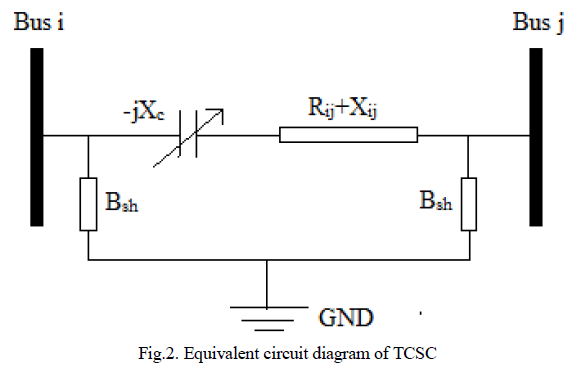 |
| Clustering is an effective way to reduce the energy consumption in WSN. Clustering can be done based on the distance and residual energy level of each sensor nodes. By determining the center point along with the mean point cluster can be formed. CH is selected using LEACH protocol based on the residual energy level. For every rounds CH will vary based on its residual energy level and average distance between sensor nodes and the BS. |
| Center point can be identified using |
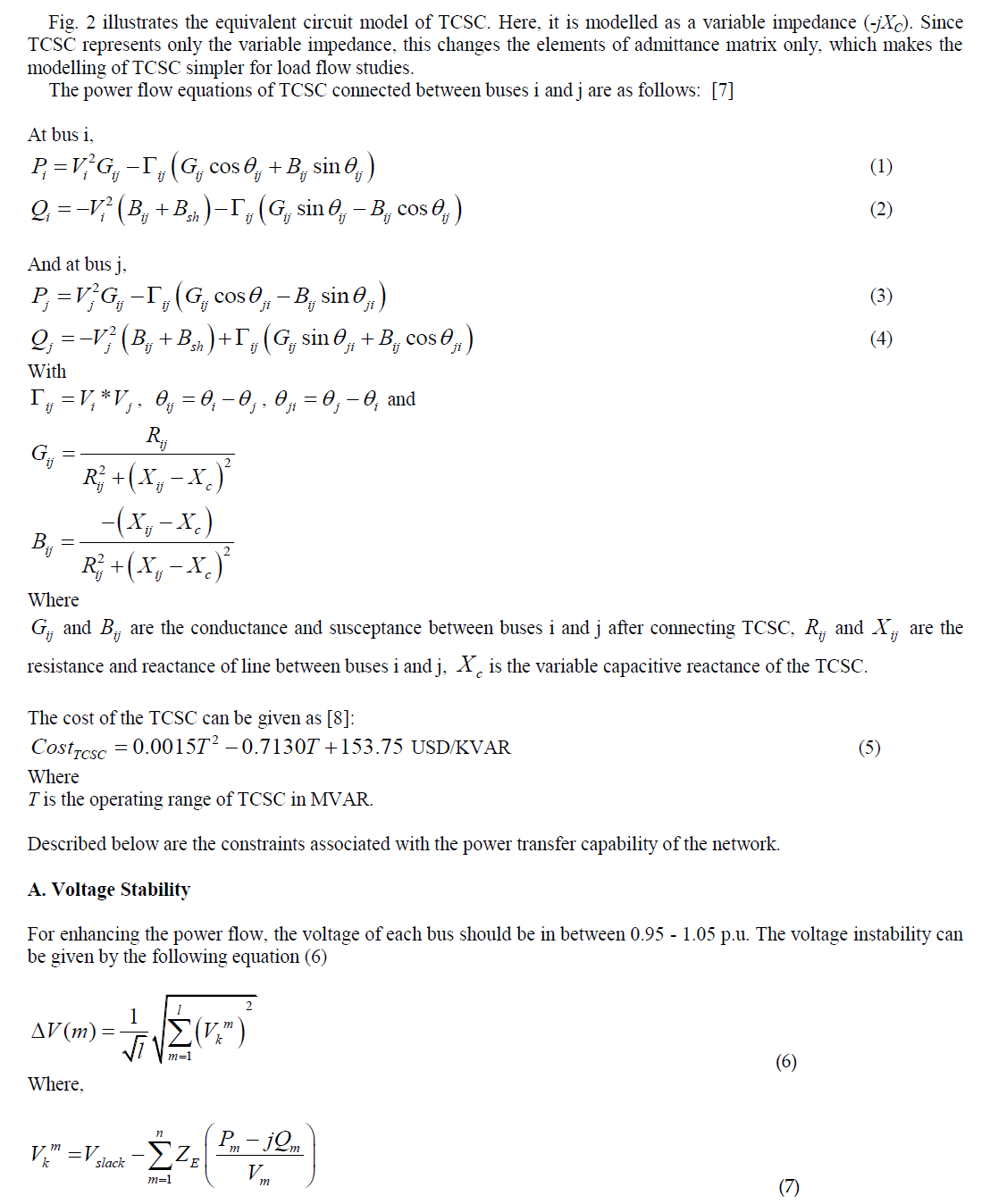 |
| Where Xi is the Coordinate of sensor node n is the number of nodes Average Distance between Two Sensor Nodes can be calculated using |
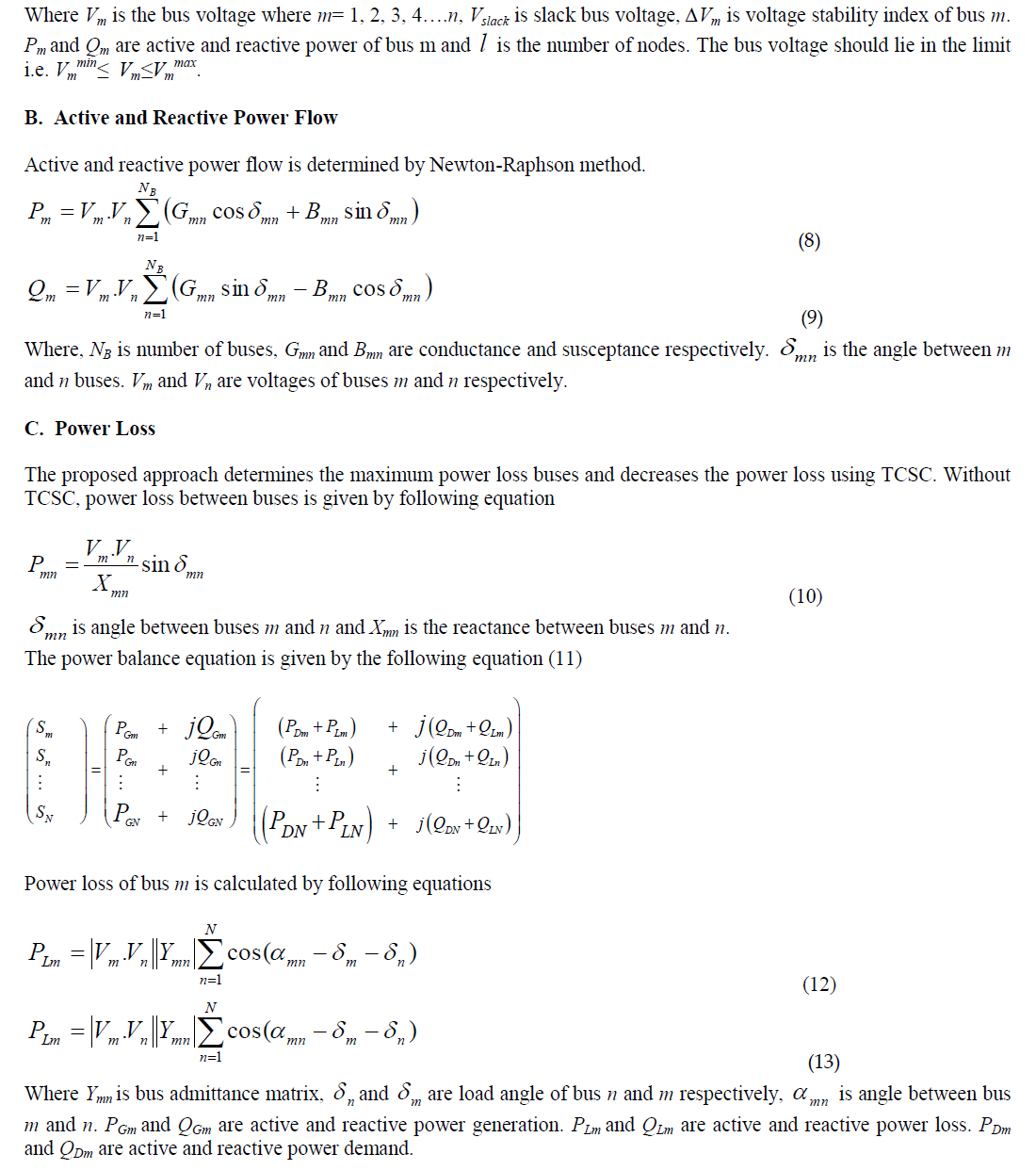 |
| Where C is the center point |
| Determining the center point on the basis of total number of nodes in the entire network using the coordinate sensor nodes center point can be fixed. Then, mean point of each sensor nodes to the center point can be determined. Average distance can be identified; using the distance clusters can be formed from those clusters CH can be chosen based on the residual energy level.CH collects the data from all other sensor nodes in a single individual cluster and then all the data are aggregated and compressed using signal processing and then aggregated data are transmitted to the BS. |
| B. Steady-State Phase |
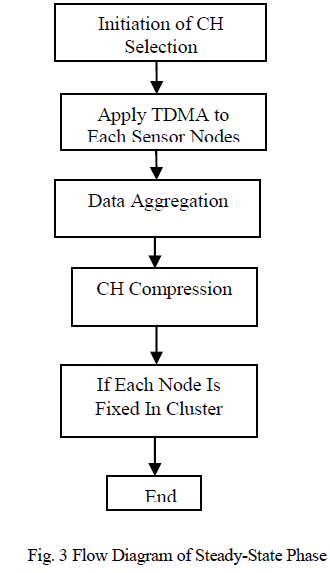 |
| After selecting the CH, each sensor nodes is allocated with TDMA schedule. The non-cluster head nodes send data to the cluster head node during their allocated transmission time. When all the data have been received, the cluster head node performs signal processing to compress the data into single signal. Then this signal is sent to the BS. |
| The amount of information is reduced due to the data aggregation done at the CH node. Due to the data aggregation and compression energy consumption in the CH is reduced. To avoid unnecessary nodes control message transmission and control overhead of the BS, the clusters are re-created only when the sensor nodes cannot work in a certain round. A source node in the wireless sensor network consists of multiple paths to reach a destination node. The entire total number of nodes is based on the application level and the node usage. The nodes are randomly deployed in the 1000 *1000 network area. Main goal of this project is to reduce the energy level in CH and to increase the network lifetime of WSN. The overall energy level in WSN is expressed as joules. The Joule is a measure of electrical power of the sensor, represented as “J”. Each sensor node consumes different levels of energy for data transmission. Nodes which are in active mode consumes certain amount of energy, nodes which are in sleep mode consumes only small amount of energy. CH consumes lot of energy while receiving the data from all other sensor nodes and as well as transmitting the information to the BS. |
SIMULATION ENVIRONMENT |
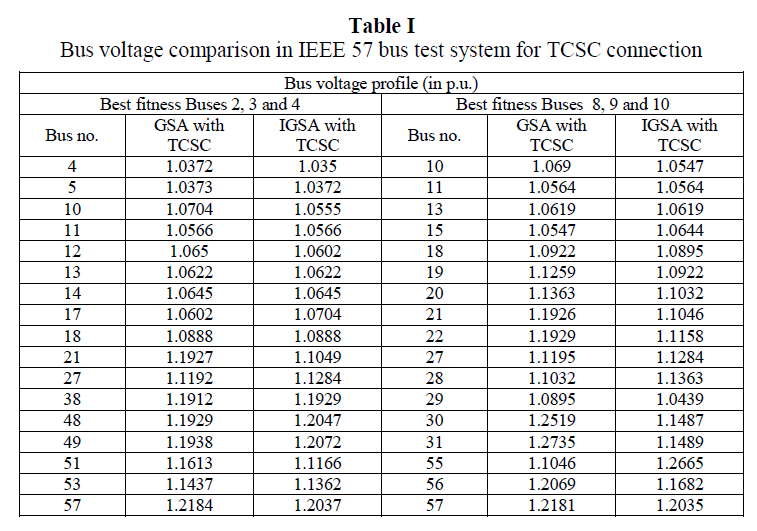 |
| For the implementation of the proposed work simulator NS-2.26 is used. Number of nodes 57 is randomly deployed in 1000*1000m area. Initial energy of each node is set to 10j/node. Cluster is formed based on the distance, 10 clusters are formed. The simulation environment is composed of a BS and some sensor nodes. The BS is fixed and located far from the sensor nodes. The location of each sensor node is randomly distributed in the sensing area. The non-cluster head node can monitor the environment and send data to the cluster head node. The cluster head node can gather data, compress it, and forward to the BS. All sensor nodes are stationary and the initial energy is the same for each sensor node. A round is defined as the receiving data from all sensor nodes to the BS. The total network energy is defined as the sum of residual energy at all sensor nodes. Cluster head formation with LEACH protocol, the BS receives the information of location and residual energy for each sensor node and the average residual energy can be calculated. When the residual energy of sensor node is higher than the average residual energy, the sensor node becomes a candidate of cluster head. Clustering is an effective way to reduce the energy consumption in WSN. Clustering can be done based on the distance and residual energy level of each sensor nodes. By determining the centre point along with the mean point cluster can be formed. CH is selected using LEACH protocol based on the residual energy level. |
PERFORMANCE ANALYSIS |
| Our proposed SECA scheme is higher than that of LEACH, HEED, and LEACH-C schemes after 900 runs. This is because our proposed SECA scheme provides the uniform cluster location and better cluster formation. The data transmission distance from each sensor node to its cluster head node is minimized. Thus, the energy consumption is saved. When the number of sensor nodes is 150. The distributions of clusters in LEACH and HEED are not uniform and some clusters consist of huge number of sensor node in a large area. Hence, the cluster head of the cluster with huge number of sensor nodes will suffer from heavy traffic load but our scheme improves the energy utility more significantly than LEACH, HEED, and LEACH-C schemes when the sensing nodes and area is extended. From the simulation results, it is clear that our proposed scheme strikes the appropriate performance in the energy consumption and extends the lifetime of sensor node efficiently. |
| In the proposed scheme, we calculate the average distance between the sensor nodes and take into account the residual energy for selecting the appropriate cluster head nodes. The lifetime of wireless sensor networks is extended by using the uniform cluster location and balancing the network loading among the clusters. Simulation results indicate our proposed algorithm achievements. |
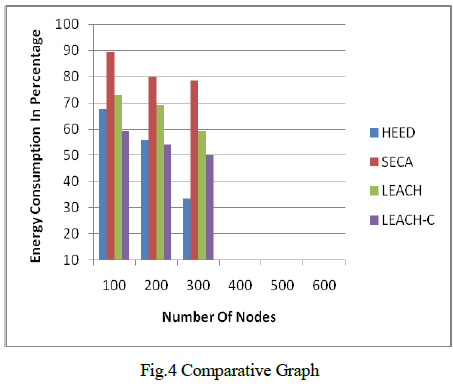 |
| Fig. 4 represents the comparative study about several protocols such as HEED, SECA, LEACH, and LEACH-C. By increasing the number of nodes in the network, the energy is consumed at various levels in each protocol are determined and shown in the above graph. |
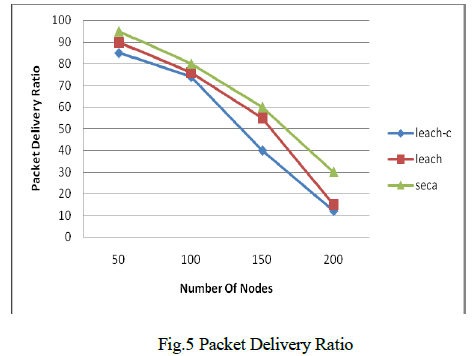 |
| Fig. 5 represents the packet delivery ratio of three protocols such as LEACH-C, LEACH, and SECA. In which our proposed SECA protocol achieves prominent results than the other protocols. |
CONCLUSION |
| Though the Wireless Sensor Networks have a wide range of application and advantages, all these can be achieved by means of energy available with the sensor nodes. So the energy should be efficiently utilized. Several works have been proposed to improve the energy efficiency. In this proposed work LEACH protocol is used for efficient cluster head selection. After the cluster head selection, data are aggregated and all the aggregated data are compressed and then, transferred to the Base Station. Saving Energy and Clustering Algorithm (SECA) is designed with the aim of reducing energy consumption mainly on CH. Hence it is considered to be more efficient than other algorithms. |
References |
|